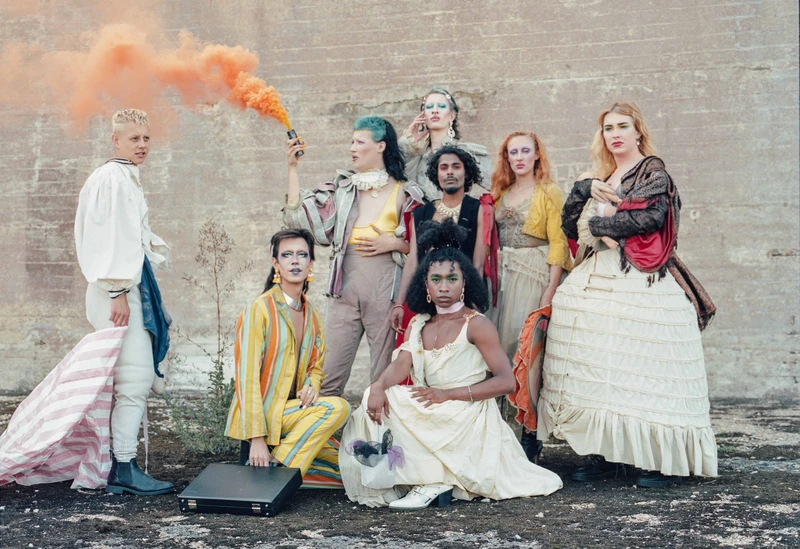May You of a Better Future
17 Feb-12 Mar 2022
PV 17 Feb 2022, 6-9pm


As part of LGBTQIA+ History Month, May You of a Better Future brings together the work of four artists in an exhibition that explores themes relating to Section 28 and its legacies through photography, film, and installation.
Introduced by the Thatcher government, Section 28 of the Local Government Act 1988 came into force on 24 May 1988 and was eventually repealed in Scotland in 2000 and in England and Wales in 2003. It provided that ‘a local authority shall not: (a) intentionally promote homosexuality or publish material with the intention of promoting homosexuality; (b) promote the teaching in any maintained school of the acceptability of homosexuality as a pretended family relationship.‘
Purposefully ambiguous, critics argued that the formulation of the clause involved ‘logical impossibility’ and was so flawed that ‘in reality there is little to fear from Section 28 but fear itself’, that its most potent effect was a symbol of the prejudice of the UK Parliament. This however underestimated the impact it would have on local authorities, with councils forced to close LGBTQIA+ support groups, libraries removing gay and lesbian themed literature from their collections and public venues avoiding LGBTQIA+ related programming. Its most insidious and perhaps immeasurable impact occurred however in the classroom. Although it was suggested that nothing in the clause was intended to stop teachers from discussing homosexuality with pupils objectively, it legitimised homophobia and prompted self-censorship in state education.
Whilst Section 28 is an example of a law too vague to be enforced on a widespread basis, the inherent danger was always its scope for non-legal impact. The product of ignorance, fear and hate, the legislation symbolised not only the prejudice of the UK Parliament but more widely a system of moral prejudice codified in law, deeply embedded within our society.
In her essay on paranoid and reparative reading, Eve Kosofsky Sedgwick, writes that paranoia is anticipatory, reflexive and mimetic, and places its faith in exposure. To read from a reparative position, she argues, is to recognise in paranoia its anticipatory nature and its aversion to surprise and surrender the knowing, anxious paranoid determination to foresee (however unthinkable) all possible eventualities. For the generations who lived through the beginnings of a fragmented process of decriminalisation in the UK, the shift in societal attitudes towards homosexuality in response to HIV/AIDS, and a sharp deterioration in LGBTQIA+ civil liberties under Section 28, perhaps a paranoid position is inevitable. Sedgwick notes that ‘it is sometimes the most paranoid-tending people who are able to, and need to, develop and disseminate the richest reparative practices’.
May You of a Better Future brings together a group of artists who embrace reparative practices. Holly Buckle’s work creates a safe space for us to piece together LGBTQIA+ history, to reflect upon it, to lay with it, to open up a conversation and educate ourselves in relation to it. Sunil Gupta’s series ‘Pretended’ Family Relationships* focuses on the gay and lesbian communities’ vigorous response to Section 28 at the time it came into force, each photograph a document of love and a reminder of the power in protest. Emil Lombardo’s work, concerned with body politics and gender, representation and visibility of dissident identities, counters the legacy of the legislation in our collective unconscious. Whilst Joseph Wilson’s film reimagines the lives of queer people in the late 80s and 90s had we instead been banished from the UK under Section 28, the work’s title Il-Widna referencing sound mirrors developed between the World Wars, significant in the film as they amplify our collective queer voice.
Section 28 was effective as an alienating and oppressive form of censorship in creating a culture of silence around sexuality and gender identity in public institutions and in state education. Yet it somehow slipped from the public consciousness upon its repeal. Its legacy lives on and its enduring impact is felt by the generation in state education whilst it remained in force and by subsequent generations, unaware of its existence.
Sedgwick concludes her essay by suggesting that “what we can best learn from reparative practices, are, perhaps, the many ways selves and communities succeed in extracting sustenance from the objects of a culture – even of a culture whose avowed desire has often been not to sustain them.”
May You of a Better Future is a reflection of this, serving as a point of departure for discussion and forming part of a wider project of education and repair.
May You of a Better Future | Press Release
Download